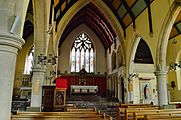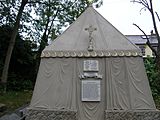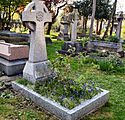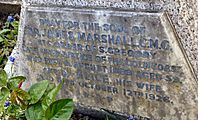St Mary Magdalen Roman Catholic Church, Mortlake facts for kids
Quick facts for kids St Mary Magdalen Roman Catholic Church, Mortlake |
|
|---|---|
 |
|
| Location | 61 North Worple Way, Mortlake, London SW14 8PR |
| Country | England, United Kingdom |
| Denomination | Roman Catholic |
| Architecture | |
| Architect(s) | Gilbert Blount |
| Style | Gothic Revival |
| Years built | 1852 |
| Administration | |
| Parish | Mortlake |
| Deanery | Mortlake |
| Diocese | Roman Catholic Archdiocese of Southwark |
| Province | Southwark |
St Mary Magdalen Roman Catholic Church, Mortlake, is a Roman Catholic church in Mortlake, London. It is named after Mary Magdalene, a close friend of Jesus. The church is found on North Worple Way. It is near Mortlake High Street and another church, St Mary the Virgin. St Mary Magdalen's Catholic Primary School is also very close by.
The church building was designed by Gilbert Blount, a well-known architect. It was built in 1852. The style of the building is called Gothic Revival, which means it looks like older medieval churches.
Contents
Church History
The first priest of this church was Father John Wenham. He used to be an Anglican army chaplain in Ceylon (now Sri Lanka). He later became a Catholic. Father Wenham is buried in the churchyard.
Beautiful Stained-Glass Windows
The church has many amazing stained-glass windows. These windows tell stories from the Bible and show important people.
East Window
The east window was made around 1850 by William Wailes. It shows St Mary Magdalen in the middle. On the right, it shows the Noli me tangere scene. This is when Jesus appears to Mary Magdalene after his resurrection. On the left, there are scenes from Luke's Gospel.
West Window
The west window is more modern, from the 20th century. Its main idea is "Through Cross to Crown." It shows Noli me tangere again, and also the Crucifixion (Jesus on the cross). Other parts show Our Lady Queen of Heaven and the Ascension (Jesus going up to heaven).
Lady Chapel Windows
In the Lady Chapel, the east window shows three saints: St Catherine of Siena, St Mary, and St Robert of Arbrissel. This window was a gift from Catherine Strickland-Standish. The north window in this chapel shows the Annunciation, which is when the Angel Gabriel told Mary she would have Jesus.
Sacred Heart Window
The Sacred Heart window shows Mary receiving Communion. The Sacred Heart is in the middle of the window. On the right, you can see St Margaret Mary Alacoque. Below this, there is a scene from the Last Supper.
Law Memorial Window
The Law memorial window was made around 1886. It shows St William, Our Lady, Star of the Sea, and St Francis Xavier. This window remembers the Hon. William Towry Law. He was a important church official who became Catholic in 1851. His son, Rev. Augustus Henry Law SJ, was a missionary priest who died in Rhodesia. The window also shows William Towry Law praying and his son during his last illness.
First World War Memorial Window
This window remembers those who fought in the First World War. It shows St George and St Patrick. They are on either side of St Michael the Archangel.
Burton Window
The Burton window shows St Mary Magdalen, St Joseph, and St Agnes. Below, it shows Sir Richard Burton as a knight praying.
Churchyard Burials
Many people are buried in the churchyard of St Mary Magdalen. The first burial happened in 1853.
Frances Margaret Taylor (1832–1900) was buried here. She started a Catholic religious group called the Poor Servants of the Mother of God. Her remains were later moved to a chapel in Roehampton. More than 80 sisters from her order are buried in this churchyard.
Other notable people buried here include:
- Arthur William à Beckett (1844–1909), a journalist.
- Winifred Barnes (1892–1935), an English actress and singer.
- John Francis Bentley (1839–1902), the architect who designed Westminster Cathedral.
- Katharine Harris Bradley (1846–1914) and Edith Emma Cooper (1862–1913). They were writers who used the name Michael Field.
- Henry Clutton (1819–1893), an architect.
- Ernest Law (1854–1930), a historian.
- Leonard Stokes (1858–1925), an architect who designed many Catholic buildings. He was also president of the Royal Institute of British Architects.
- His brother, Sir Frederick Wilfrid Stokes (1860–1927), an engineer. He invented the Stokes Mortar, a weapon used in the First World War.
Sir Richard and Lady Burton's Mausoleum
The churchyard has a special tomb for the famous Victorian explorer Sir Richard Burton (1821–1890). His wife, Isabel, Lady Burton (1831–1896), is also buried there. She designed their unique tent-shaped tomb. It is made of Carrara marble and stone. Lady Burton also put up a memorial stained-glass window for her husband inside the church.
Comte de Vezlo Mausoleum
Another tomb in the cemetery belongs to the very young Comte de Vezlo, Guilaume Henri (1894–1901). A plaque also remembers his mother, Annette Rosamonde Blasio, the Comtesse de Vezlo.
Sir James Marshall's Grave
Sir James Marshall (1829–1889) is buried in the churchyard. He was a British judge who helped spread Catholicism in Ghana and Nigeria. His wife Alice is also buried with him. A special plaque for him was put up inside the church in 1999.
A group of Ghanaian Catholics, called the Knights and Ladies of Marshall, visit the church every year. They celebrate a special Mass to remember Sir James Marshall.
War Graves
The cemetery also contains the graves of six service members. Four died in World War I and two in World War II. These graves are cared for by the Commonwealth War Graves Commission.
Images for kids
More Pictures
See also











